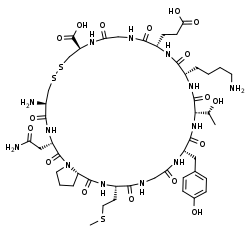Cyclotraxin B
Cyclotraxin B (CTX-B) is a small (1200 Da) cyclic peptide and highly potent, selective, non-competitive antagonist or negative allosteric modulator of TrkB (IC50 = 0.30 nM),[1][2] the main receptor of brain-derived neurotrophic factor (BDNF), which itself was derived from BDNF.[1][3] It crosses the blood-brain-barrier with systemic administration and produces anxiolytic-like effects in animals, though notably not antidepressant-like effects.[1][4] The compound has also been found to produce analgesic effects in animal models of neuropathic pain.[5] In addition to TrkB, CTX-B has been found to be an allosteric modulator of VEGFR2, one of the receptors of vascular endothelial growth factor (VEGF).[2]
 | |
| Clinical data | |
|---|---|
| Other names | CTX-B |
| ATC code |
|
| Identifiers | |
| |
| CAS Number | |
| PubChem CID | |
| ChemSpider | |
| Chemical and physical data | |
| Formula | C48H73N13O17S3 |
| Molar mass | 1200.37 g·mol−1 |
| 3D model (JSmol) | |
| |
| |
References
- Cazorla M, Jouvenceau A, Rose C, Guilloux JP, Pilon C, Dranovsky A, Prémont J (March 2010). "Cyclotraxin-B, the first highly potent and selective TrkB inhibitor, has anxiolytic properties in mice". PLOS ONE. 5 (3): e9777. Bibcode:2010PLoSO...5.9777C. doi:10.1371/journal.pone.0009777. PMC 2841647. PMID 20333308.
- De Smet F, Christopoulos A, Carmeliet P (November 2014). "Allosteric targeting of receptor tyrosine kinases". Nature Biotechnology. 32 (11): 1113–20. doi:10.1038/nbt.3028. PMID 25380447. S2CID 12609911.
- Growth Factor Receptors—Advances in Research and Application: 2013 Edition. ScholarlyEditions. 21 June 2013. pp. 42–. ISBN 978-1-4816-7619-9.
- Advances in Physiology Research and Application: 2011 Edition. ScholarlyEditions. 9 January 2012. pp. 1431–. ISBN 978-1-4649-2075-2.
- Constandil L, Goich M, Hernández A, Bourgeais L, Cazorla M, Hamon M, et al. (June 2012). "Cyclotraxin-B, a new TrkB antagonist, and glial blockade by propentofylline, equally prevent and reverse cold allodynia induced by BDNF or partial infraorbital nerve constriction in mice". The Journal of Pain. 13 (6): 579–89. doi:10.1016/j.jpain.2012.03.008. PMID 22560237.
This article is issued from Wikipedia. The text is licensed under Creative Commons - Attribution - Sharealike. Additional terms may apply for the media files.